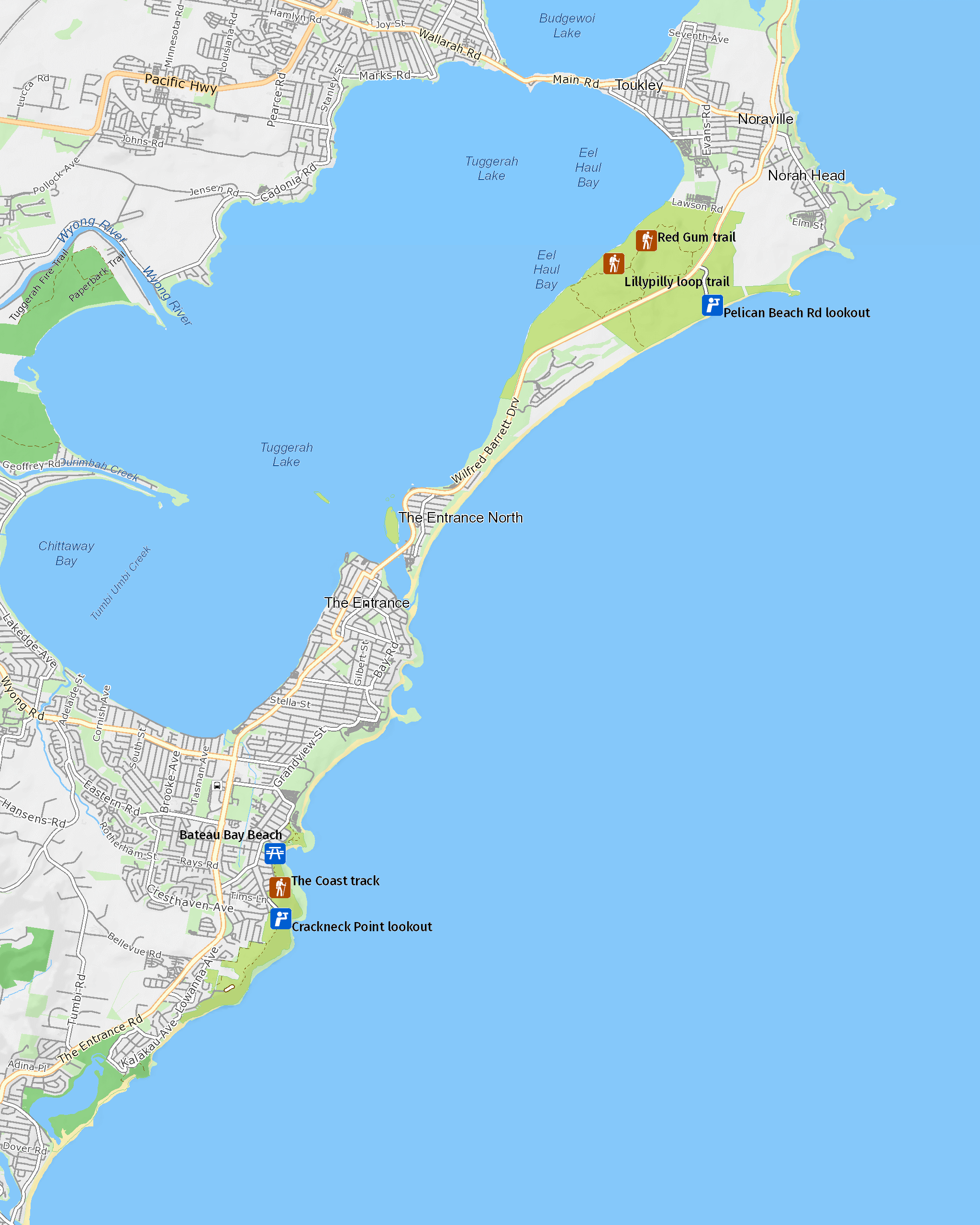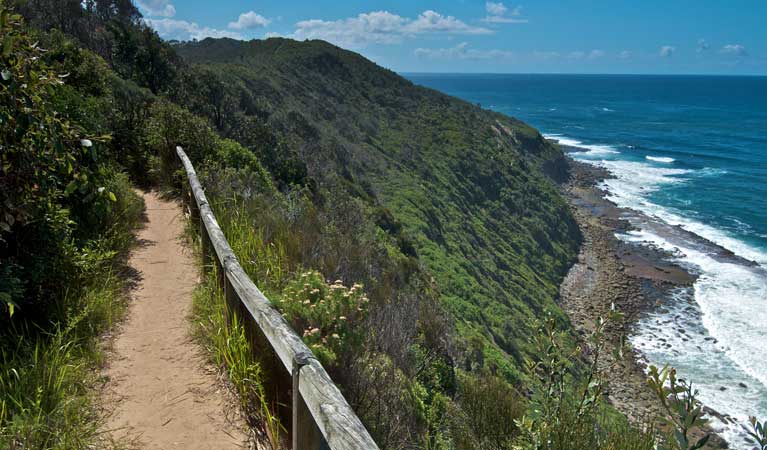Wyrrabalong National Park
Overview
Discover paradise just minutes from The Entrance on the Central Coast. Go whale watching, fishing, surfing, bushwalking and birdwatching at Wyrrabalong National Park.
Read more about Wyrrabalong National Park
Divided into two sections, Wyrrabalong National Park conserves the last patch of coastal rainforest on the Central Coast. Visit this precious place to swim, surf and fish along a striking coastline and be awed by the superb red gum forest, diverse wildlife and rich Aboriginal heritage.
Take a walk along the beach to see how the park’s sandy beaches alternate with rocky cliffs pounded by the sea. Look to the sky for eagles and kestrels. Explore the park’s varied landscape on a network of walking tracks, or stop at its picnic areas and enjoy picture-perfect surroundings. There’s a few bike trails in the park to explore as well.
Soak up dramatic coastal views and take in the spectacular sight of whales on their annual migration – the park is a hot spot for whale watching.
Local alerts
For the latest updates on fires, closures and other alerts in this area, see https://www.nationalparks.nsw.gov.au/visit-a-park/parks/wyrrabalong-national-park/local-alerts
Map

Map legend

Contact
- in the Sydney and surrounds region
Wyrrabalong National Park is open from 5.30am to 8pm during daylight saving and 5.30am to 6pm rest of year.
-
-
Lake Munmorah office
02 4972 9000
Contact hours: Monday to Friday, 8.30am to 4pm. - 1 Blue Wren Drive, Wybung NSW 2259
-
Email: npws.centralcoast@environment.nsw.gov.au
-
Lake Munmorah office
-
-
Girrakool office
02 4320 4200
Contact hours: Monday to Friday, hours vary. - 59 Girrakool Rd, Somersby, NSW 2250
-
Email: npws.centralcoast@environment.nsw.gov.au
-
Girrakool office
Visitor info
All the practical information you need to know about Wyrrabalong National Park.
Maps and downloads
Nearby towns
Gosford (16 km)
Gosford is a great destination for a family day trip or holiday. It's situated on Brisbane Water National Park and surrounded by state forests, lakes and beaches.
Newcastle (57 km)
Newcastle is a harbour city surrounded by amazing surf beaches that are linked by a great coastal walk, the Bathers Way. The walk from Nobbys Beach to Merewether Beach takes about three hours and is a great way to explore the city.
Hornsby (69 km)
A suburb in Sydney's upper north shore, Hornsby is conveniently located for easy access to Lane Cove National Park, Berowra Valley Regional Park, and the heritage-listed Ku-ring-gai Chase National Park - Australia's second-oldest national park. Explore walking and cycling tracks and Aboriginal sites, as well as marinas, cafes and picnic areas.
Learn more
Wyrrabalong National Park is a special place. Here are just some of the reasons why:
Whale watching

The park's spectacular coastal lookouts - both north and south - are ideal vantage points for whale watchers. Bring your binoculars to Crackneck Point lookout in whale watching season and prepare to be astounded. Whales are frequently seen breaching and tail-slapping nearby. And watch for the blow as they surface for air - there's really nothing like it.
- Tandem paragliding on the NSW Central Coast Take a tandem flight with Cloudbase Paragliding and be treated to a stunning bird’s eye view of Wyrrabalong National Park on the NSW Central Coast.
Aboriginal culture

North Wyrrabalong forms part of traditional Country of the Awabakal People, with south Wyrrabalong (cut off from the north by The Entrance channel) being Darkinjung Country. The park has a rich Aboriginal history and protects many significant cultural sites, including an extensive midden at Pelican Point. You can take a guided tour with Nyanga Walang to find out more about local Darkinjung history.
- Wyrrabalong Aboriginal cultural tour Walk alongside an Aboriginal guide in Wyrrabalong National Park and learn about the plants, animals and landscape while listening to cultural stories.
Red gum forest

The northern section of Wyrrabalong National Park protects the largest stand of Sydney red gums, or Angophoras, on the Central Coast. Explore the red gum forest and enjoy the shade of these magnificent native trees along the Red Gum trail in north Wyrrabalong. See how the forest changes depending on the season – trunks change from orange in summer to pinkish-grey in winter. Visit around December to see the trees adorned with white flowers, and spot honeyeaters in the branches in wintertime. The park is also an important haven for a variety of wildlife, including a number of threatened migratory birds that visit the coastal strip between Forresters Beach and Blue Lagoon in the park’s southern section. There’s even a population of marine turtles in Tuggerah Lake – if you’re lucky, you might see a loggerhead turtle; they have a large head in proportion to the rest of its body.
- Junior ranger: Whale tales at Wyrrabalong Hey junior whale watchers! These school holidays have fun whale watching at Crackneck Point lookout in Wyrrabalong National Park, near The Entrance. Learn how to spot whales on their annual migration.
- Lillypilly loop trail The easy Lillypilly loop trail is a lovely rainforest walk on the NSW Central Coast. Enjoy birdwatching and scenic views over Tuggerah Lakes.
- Pelican Beach Road lookout Pelican Beach Road lookout offers scenic views over The Entrance and Pelican Beach and is a great spot for whale watching. The beach is popular for fishing and surfing.
- Wyrrabalong Aboriginal cultural tour Walk alongside an Aboriginal guide in Wyrrabalong National Park and learn about the plants, animals and landscape while listening to cultural stories.
Plants and animals protected in this park
Animals
-

Australian pelican (Pelecanus conspicillatus)
The curious pelican is Australia’s largest flying bird and has the longest bill of any bird in the world. These Australian birds are found throughout Australian waterways and the pelican uses its throat pouch to trawl for fish. Pelicans breed all year round, congregating in large colonies on secluded beaches and islands.
-

Brown-striped frog (Lymnastes peronii)
One of the most common frogs found in Australia, the ground-dwelling brown-striped frog lives in ponds, dams and swamps along the east coast. Also known as the striped marsh frog, this amphibian grows to 6.5cm across and has a distinctive ‘tok’ call that can be heard all year round.
Plants
-

Cabbage palm (Livistona australis)
With glossy green leaves spanning 3-4m in length and a trunk reaching a height of up to 30m, the cabbage tree palm, or fan palm, is one of the tallest Australian native plants. Thriving in rainforest margins along the east coast of NSW, in summer this giant palm produces striking spikes of cream flowers which resemble cabbages.
-

Old man banksia (Banksia serrata)
Hardy Australian native plants, old man banksias can be found along the coast, and in the dry sclerophyll forests and sandstone mountain ranges of NSW. With roughened bark and gnarled limbs, they produce a distinctive cylindrical yellow-green banksia flower which blossoms from summer to early autumn.
Environments in this park
Education resources (1)
What we're doing
Wyrrabalong National Park has management strategies in place to protect and conserve the values of this park. View the detailed park and fire management documents. Here is just some of the work we’re doing to conserve these values:
Preserving biodiversity
Wyrrabalong National Park upholds its biodiversity by protecting vulnerable, threatened and endangered species. Conservation activities are carried out in this park and include surveys and data collection on species distribution and population.
Managing weeds, pest animals and other threats
Pests and weeds have a significant impact to the ecosystems within Wyrrabalong National Park. NPWS carries out risk assesments for new and emerging weeds as well as Bitou bush and boneseed control to protect biodiversity in this park.
Developing visitor facilities and experiences
Maintaining Wyrrabalong National Park’s visitor facilities is an NPWS priority. Programs relating to the upkeep and enhancement of the park’s lookouts, tracks, trails and other offerings are ongoing.
General enquiries
- National Parks Contact Centre
- 7am to 7pm daily
- 1300 072 757 (13000 PARKS) for the cost of a local call within Australia excluding mobiles
- parks.info@environment.nsw.gov.au
Contact
- in the Sydney and surrounds region
Wyrrabalong National Park is open from 5.30am to 8pm during daylight saving and 5.30am to 6pm rest of year.
-
-
Lake Munmorah office
02 4972 9000
Contact hours: Monday to Friday, 8.30am to 4pm. - 1 Blue Wren Drive, Wybung NSW 2259
-
Email: npws.centralcoast@environment.nsw.gov.au
-
Lake Munmorah office
-
-
Girrakool office
02 4320 4200
Contact hours: Monday to Friday, hours vary. - 59 Girrakool Rd, Somersby, NSW 2250
-
Email: npws.centralcoast@environment.nsw.gov.au
-
Girrakool office

